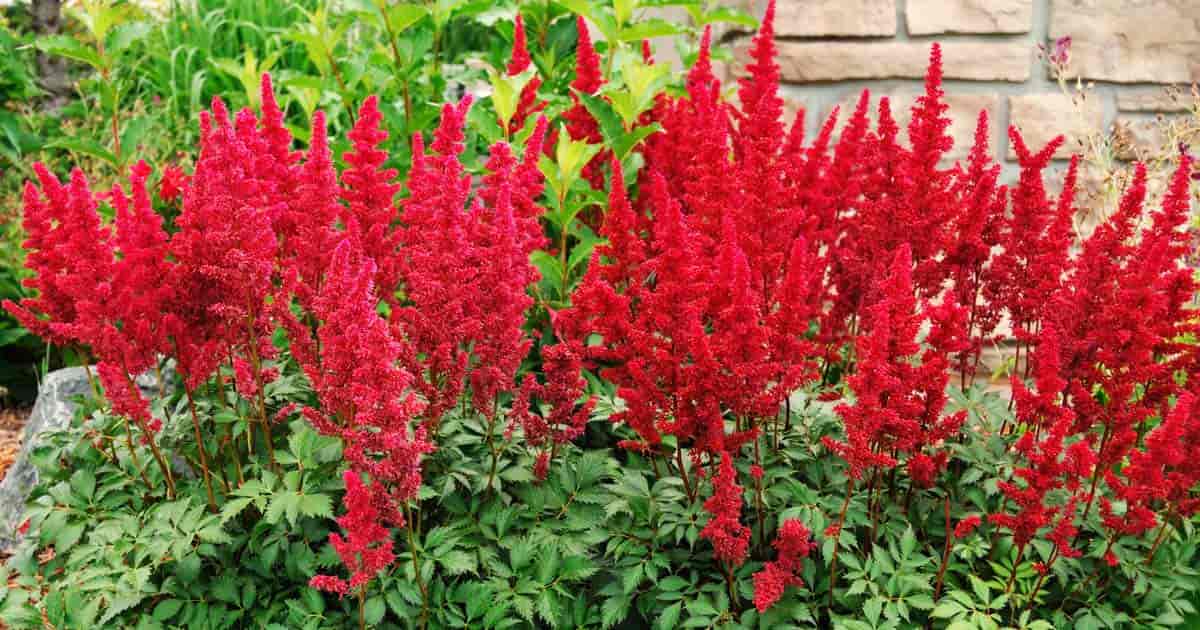With fern-like foliage and beautiful showy flowers atop, Astilbe fanal [a-STIL-bee X ar-END-see-eye] (Astilbe x arendsii hybrid) is a perennial plant belonging to the Saxifragaceae family.
In 1993 it won the Award of Garden Merit from the Royal Horticultural Society.

They are commonly seen as the focal point of summer flower beds, characterized by their tall, fluffy plumes.
Plants like hosta and hellebores are used to create contrasting foliage for coordinating blooms and creating a full flower bed.
When planted properly, it’s very low maintenance and virtually pest-free.
The long-blooming soft shades of red, pink, and white lighten up any garden, whether in full shade or a light sunny location.
This plant’s common names include:
- Astilbe
- False Goat’s Beard
- Meadowsweet
- False Spirea
Astilbe Fanal Care
Size & Growth
The rhizomatous flowering Astilbe plant blooms its striking flowers during the early spring and early summer.
For optimal growth, plant in early or late spring or fall.
When planting in the summer, avoid doing so when it’s the hottest part of the season.
Make sure to keep the plant well-hydrated.
The size of the plant can vary depending on the variety and the location you plant them in.
Astilbe grows anywhere from 6″ inches to 2′ feet in height.
As for the spread, it’s quite luscious and covers anywhere from 6″ inches to 5′ feet in diameter.
Due to the size and spread of the plant, it’s popular among gardening enthusiasts as a focal point in large gardening beds.
Overall its growth rate is moderate.
Flowering and Fragrance
The bloom time is from mid-spring to late summer.
If you mix and match different types of Astilbe, it prolongs the bloom almost the entire season.
The flowers appear as red plume-like panicles at the tops of the plant.
Astilbe blooms with deep red flower colors on top of dark-green foliage.
The flowers look striking against the bronze-green foliage color.
The fragrant flowers remain in bloom for weeks and continue to look beautiful as they slowly dry on the plant.
Light & Temperature
Even though this plant grows in full sun, it does best when planted in wet shady area locations.
If you do plant Astilbe in a sunny location, provide some shade during the hottest part of the season as the foliage can burn.
This plant doesn’t do well in droughts and will brown and die if left dry for prolonged periods.
If you live in a cold climate, lay down at least 2″ inches of mulch around the stem before the first frost comes.
This regulates temperature and retains soil moisture.
Astilbe is very hardy and adaptable from USDA hardiness zones 3 to 8.
Watering and Feeding
As mentioned this plant doesn’t do well in dry conditions.
Consequently, it needs to be watered frequently, but avoid overwatering.
The warmer and hotter the weather is, the more water the plant will need.
Astilbe requires a sufficient amount of phosphorus to bloom.
Use a fertilizer with a 5-10-5 or 10-10-10 makeup and rake it into the soil.
Fertilize once every spring when the ground is wet.
Soil & Transplanting
This plant loves soil rich in organic matter.
It thrives in slightly acidic soil with a soil pH of around 6.0.
Since they don’t do well in dry conditions, make sure the soil is moist at all times but without standing water.
Transplanting is recommended as it grows quickly.
Every four to five years, divide the plants to keep them at optimal health.
Make sure to keep them hydrated and positioned in a partially sunny location so they can re-establish quickly.
When planting bare-root plants, make the holes are twice as wide as the plants and 4″ – 6″ inches deep.
Grooming and Maintenance
Deadheading is not needed unless you don’t like the look of the faded flower stalks.
If allowed to remain, the dried seedheads will provide additional interest later in the season.
The flowers will dry on the stalks and won’t need cutting until they start to look ragged.
Astilbe is pretty low maintenance and doesn’t require much pruning.
However, make sure to divide and repot them every few years to manage the spread and maintain the plant’s health.
How to Propagate Fanal Astible
Astilbe propagates by division.
The flowers on the plant are sterile.
Even though seeds are available, they are hard to germinate.
Division is the easiest way to propagate.
- After 4-5 years, divide the plant and repot in slightly rich and moist soil.
- Keep in a partially sunny location and water as needed.
- Make sure you add fertilizer into the ground at least two weeks before repotting.
Even a small division of the plant will fill out quickly.
False Spirea Pest or Disease Problems
One of the best features of the Red Astilbe is it’s virtually trouble-free.
Problem pests include the Japanese beetle, whiteflies (in a greenhouse), black vine weevil beetles and tarnished plant bugs.
More on: How to Get Rid of Whiteflies on Plants
However, this also subsides as the plant starts filling out.
Suggested Uses for False Goat’s Beard
Astilbe is commonly used in part shade woodland gardens along with other partial shade tolerant plants.
Homeowners grow this deer resistant, rabbit resistant plant around the boundaries of their shade gardens.
Works well as a groundcover.
Astilbe makes for excellent cut flowers and looks pretty when dried out.
Great companion plants include:
- Heuchera
- Hosta Crispula
- Astrantia major
- Aquilegia vulgaris var. stellata
- Hydrangea